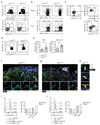Myeloid-derived suppressor cells control B cell accumulation in the central nervous system during autoimmunity
- PMID: 30374128
- PMCID: PMC6241855
- DOI: 10.1038/s41590-018-0237-5
Myeloid-derived suppressor cells control B cell accumulation in the central nervous system during autoimmunity
Abstract
Polymorphonuclear myeloid-derived suppressor cells (PMN-MDSCs) have been characterized in the context of malignancies. Here we show that PMN-MDSCs can restrain B cell accumulation during central nervous system (CNS) autoimmunity. Ly6G+ cells were recruited to the CNS during experimental autoimmune encephalomyelitis (EAE), interacted with B cells that produced the cytokines GM-CSF and interleukin-6 (IL-6), and acquired properties of PMN-MDSCs in the CNS in a manner dependent on the signal transducer STAT3. Depletion of Ly6G+ cells or dysfunction of Ly6G+ cells through conditional ablation of STAT3 led to the selective accumulation of GM-CSF-producing B cells in the CNS compartment, which in turn promoted an activated microglial phenotype and lack of recovery from EAE. The frequency of CD138+ B cells in the cerebrospinal fluid (CSF) of human subjects with multiple sclerosis was negatively correlated with the frequency of PMN-MDSCs in the CSF. Thus PMN-MDSCs might selectively control the accumulation and cytokine secretion of B cells in the inflamed CNS.
Conflict of interest statement
Figures







References
Publication types
MeSH terms
LinkOut - more resources
Full Text Sources
Other Literature Sources
Medical
Molecular Biology Databases
Miscellaneous

